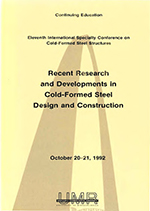Location
Saint Louis, Missouri
Session Dates
20 Oct 1992
Abstract
Generalised Beam Theory (GBT) has been developed by Professor R Schardt and his colleagues at the University of Darmstadt in Germany. The definitive reference at the present time is a recent German text(1) which describes the first-order theory. For the analysis of cold-formed sections, second-order theory may be required and this is less well documented. This paper will attempt to describe the principles involved and illustrate them by means of some practical examples. GBT unifies the conventional theories for the analysis of prismatic thin-walled structural members within a consistent notation. It then extends them into new territory. Conventional beam theory identifies four fundamental modes of deformation, namely extension, bending about two principal axes and torsion. These may be referred to as the "rigid-body" modes because they do not involve any distortion of the cross-section. Higher-order modes also exist but these involve cross-section distortion together with transverse bending. In first-order theory, all modes are orthogonal. This means that they are uncoupled and can be considered separately before their effects are combined. In second-order theory, the modes may become coupled but their orthogonal nature ensures that the coupling is minimised so that important results can often be obtained by a trivial calculation involving a single mode. GBT is a big subject with many ramifications and a full treatment is not possible within the confines of a single paper. No attempt will, therefore, be made to derive the basic equations and attention will be confined to explanation and application.
Department(s)
Civil, Architectural and Environmental Engineering
Research Center/Lab(s)
Wei-Wen Yu Center for Cold-Formed Steel Structures
Meeting Name
11th International Specialty Conference on Cold-Formed Steel Structures
Publisher
University of Missouri--Rolla
Document Version
Final Version
Rights
© 1992 University of Missouri--Rolla, All rights reserved.
Document Type
Article - Conference proceedings
File Type
text
Language
English
Recommended Citation
Davies, J. Michael and Leach, Philip, "Some Applications of Generalized Beam Theory" (1992). CCFSS Proceedings of International Specialty Conference on Cold-Formed Steel Structures (1971 - 2018). 2.
https://scholarsmine.mst.edu/isccss/11iccfss/11iccfss-session8/2
Some Applications of Generalized Beam Theory
Saint Louis, Missouri
Generalised Beam Theory (GBT) has been developed by Professor R Schardt and his colleagues at the University of Darmstadt in Germany. The definitive reference at the present time is a recent German text(1) which describes the first-order theory. For the analysis of cold-formed sections, second-order theory may be required and this is less well documented. This paper will attempt to describe the principles involved and illustrate them by means of some practical examples. GBT unifies the conventional theories for the analysis of prismatic thin-walled structural members within a consistent notation. It then extends them into new territory. Conventional beam theory identifies four fundamental modes of deformation, namely extension, bending about two principal axes and torsion. These may be referred to as the "rigid-body" modes because they do not involve any distortion of the cross-section. Higher-order modes also exist but these involve cross-section distortion together with transverse bending. In first-order theory, all modes are orthogonal. This means that they are uncoupled and can be considered separately before their effects are combined. In second-order theory, the modes may become coupled but their orthogonal nature ensures that the coupling is minimised so that important results can often be obtained by a trivial calculation involving a single mode. GBT is a big subject with many ramifications and a full treatment is not possible within the confines of a single paper. No attempt will, therefore, be made to derive the basic equations and attention will be confined to explanation and application.



